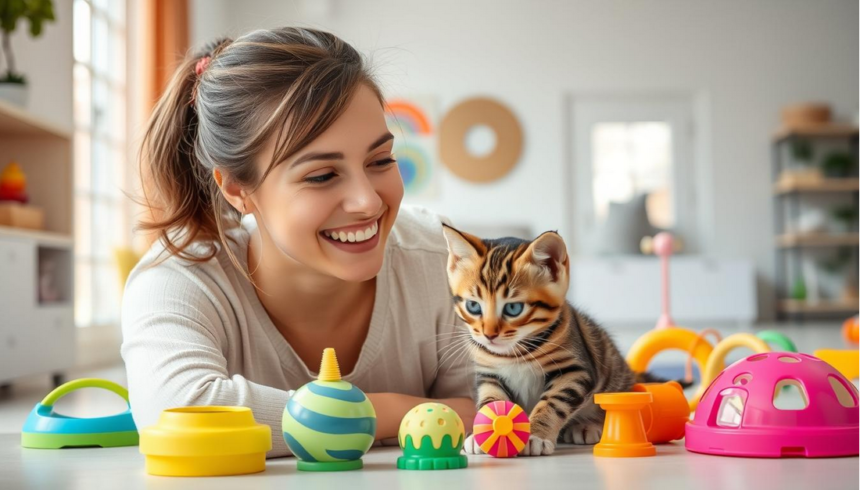India customers to view on amazon.in
Creating the Perfect Cat-Friendly Indoor Space
Designing a cat-friendly home is crucial for the well-being and happiness of your feline companion. A well-planned indoor cat environment can significantly enhance your cat’s quality of life.
- Understanding Your Cat’s Natural Needs
- Territorial Behavior and Space Requirements
- The Importance of Environmental Enrichment
- How Cats Perceive Their Environment
- Safety First: Cat-Proofing Your Home
- Identifying Common Household Hazards
- Securing Windows and Balconies
- Safe Storage of Chemicals and Medications
- Cat-Safe Plants and Toxic Plant Alternatives
- Creating the Perfect Cat-Friendly Indoor Space: Essential Elements
- Designated Resting Areas
- Feeding and Water Station Setup
- Litter Box Placement and Privacy
- Temperature and Lighting Considerations
- Vertical Space: Why Height Matters to Cats
- Cat Trees and Climbing Structures
- Wall-Mounted Shelves and Perches
- Window Access Points
- DIY Vertical Space Solutions
- Play and Exercise Areas for Indoor Cats
- Interactive Toy Selection
- Creating Engaging Play Zones
- Exercise Wheels and Activity Centers
- Rotating Toys to Maintain Interest
- Scratching Solutions: Protecting Your Furniture
- Understanding Scratching Behavior
- Types of Scratching Posts and Surfaces
- Strategic Placement of Scratching Areas
- Training Cats to Use Designated Scratching Areas
- Creating Comfort: Cozy Retreats and Hiding Spots
- The Importance of Safe Havens
- Enclosed Beds and Cat Caves
- Multi-Cat Households: Ensuring Each Cat Has Space
- Calming Products for Anxious Cats
- Sensory Enrichment for Indoor Cats
- Visual Stimulation: Bird Feeders and Digital Entertainment
- Olfactory Enrichment: Cat-Safe Plants and Herbs
- Auditory Considerations: Managing Noise Levels
- Tactile Variety: Different Textures and Surfaces
- Conclusion: Creating a Harmonious Space for You and Your Cat
- FAQ
- How much space does a cat need indoors?
- What are some essential elements for a cat-friendly indoor space?
- How can I cat-proof my home?
- What are some safe plants for a cat-friendly home?
- How can I create a stimulating environment for my indoor cat?
- What are some ways to reduce stress in indoor cats?
- How often should I rotate my cat’s toys?
- What are some DIY ideas for creating a cat-friendly indoor space?
- How can I ensure my cat gets enough exercise indoors?
- What are some tips for creating a comfortable indoor space for multiple cats?
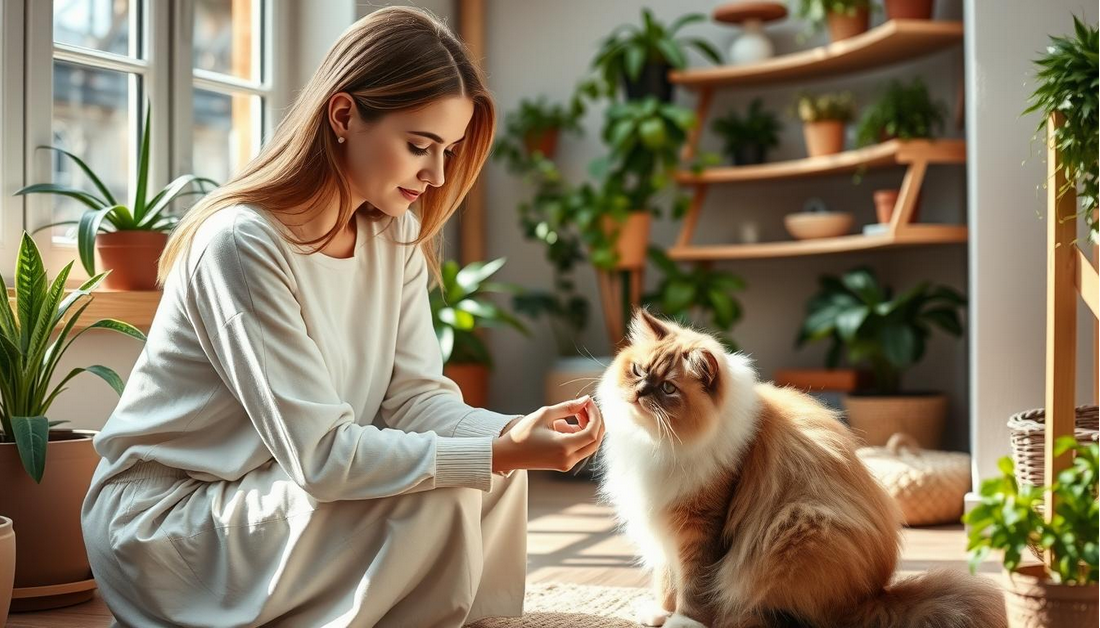
A feline-friendly living space should cater to your cat’s natural instincts, provide safety, and stimulate their physical and mental health. This involves thoughtful cat-friendly interior decor and a layout that encourages activity and relaxation.
Key Takeaways
- Understand your cat’s natural needs and behaviors.
- Design a safe and stimulating indoor environment.
- Incorporate elements that promote physical and mental health.
- Choose cat-friendly decor and furniture.
- Create a layout that encourages activity and relaxation.
Understanding Your Cat’s Natural Needs
To design the perfect indoor environment for your cat, it’s essential to grasp their inherent territorial instincts and spatial requirements. Cats are known for their territorial behavior, and understanding this aspect is crucial for creating a comfortable and secure space.
Territorial Behavior and Space Requirements
Cats are territorial animals that require a certain amount of space to feel secure and comfortable. The amount of space a cat needs can vary depending on factors such as age, size, and breed.
How Much Space Does a Cat Need?
While there’s no one-size-fits-all answer, a general rule of thumb is to provide at least 2-3 square meters of floor space per cat. However, this can vary, and it’s also important to consider vertical space for climbing and perching.
Territory Marking and Management
Cats mark their territory through scent marking, scratching, and visual marking. Managing these behaviors is crucial to maintaining a harmonious indoor environment. “Cats use scent marking to communicate with other cats, and this behavior is essential to their sense of security and identity,” says Dr. Sophia Yin, a renowned animal behaviorist.
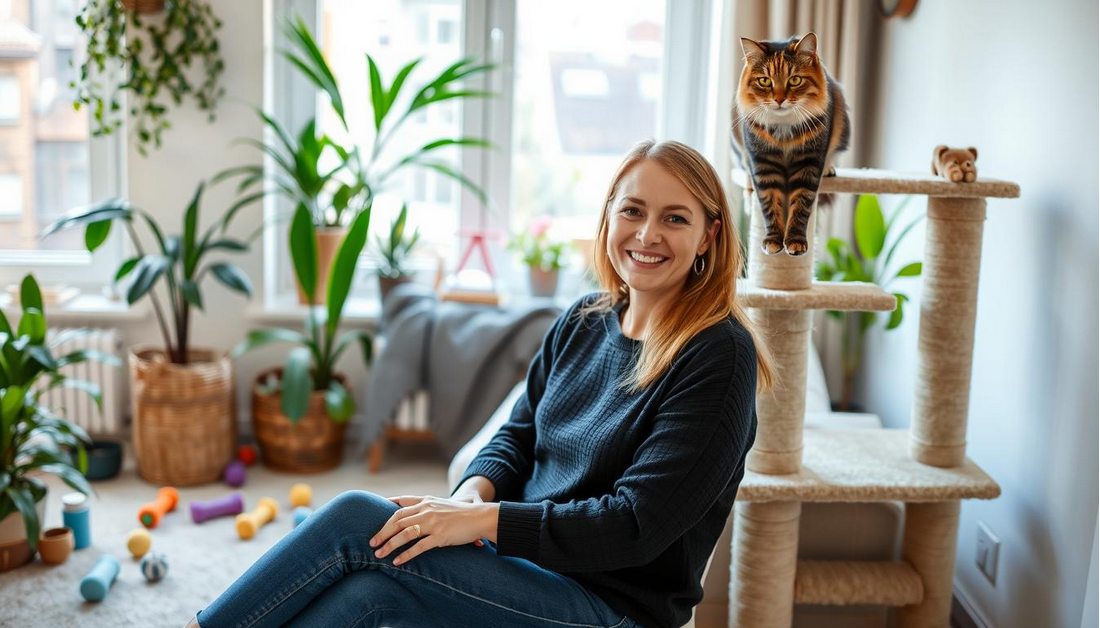
The Importance of Environmental Enrichment
Environmental enrichment is vital for a cat’s mental and physical stimulation. This can be achieved through the provision of toys, scratching posts, climbing structures, and interactive play.
How Cats Perceive Their Environment
Cats perceive their environment through a combination of senses, including sight, hearing, smell, and touch. Understanding how cats use their senses can help you design a space that meets their needs.
Feline Senses and Their Impact on Space Design
Cats have a unique visual system that is attuned to movement and changes in light. They also have a keen sense of hearing and smell. When designing a cat-friendly space, it’s essential to consider these factors to create a stimulating environment.
By understanding your cat’s natural needs and incorporating elements that cater to their territorial behavior, spatial requirements, and sensory perceptions, you can create a safe, stimulating, and comfortable indoor environment.
Safety First: Cat-Proofing Your Home
Ensuring your home is a safe haven for your cat is crucial, as their natural curiosity can often lead them into hazardous situations. Cats are known to explore their environment through touch and taste, which can sometimes put them at risk.

Identifying Common Household Hazards
One of the first steps in cat-proofing your home is to identify potential hazards. Electrical cords and blind cords can be particularly dangerous, as they can cause entanglement or electrocution.
Electrical Cords and Blind Cords
Secure cords using cord protectors or by rearranging furniture to conceal them. For blind cords, consider using cordless alternatives or safety devices that secure the cords out of reach.
Small Objects and Choking Hazards
Small objects like coins, jewelry, or batteries can be choking hazards. Keep these items out of reach by storing them in closed containers or high cabinets.
Securing Windows and Balconies
Windows and balconies can be hazardous if not properly secured. Install window guards or stops to limit how wide they can open, preventing falls.
Safe Storage of Chemicals and Medications
Chemicals and medications should be stored in secure, cat-inaccessible areas. Use locked cabinets or high shelves to prevent accidental ingestion.
Cat-Safe Plants and Toxic Plant Alternatives
Some plants are toxic to cats, so it’s essential to choose cat-safe alternatives. Consider plants like spider plants or catnip, which are safe for your feline friends.
List of Safe Indoor Plants for Cat Homes
- Spider plants
- Catnip
- Parlor palms
- Prayer plants
- Peperomia
By following these cat-proofing tips, you can create a safer, more enjoyable indoor space for your cat.
Creating the Perfect Cat-Friendly Indoor Space: Essential Elements
The perfect cat-friendly indoor space is achieved by thoughtfully integrating designated resting areas, feeding stations, litter box facilities, and appropriate temperature and lighting controls. By focusing on these essential elements, you can create a comfortable and engaging environment that meets your cat’s various needs.
Designated Resting Areas
Providing your cat with designated resting areas is crucial for their comfort and relaxation. Cats need quiet, cozy spots where they can retreat from the hustle and bustle of daily life.
Selecting the Right Cat Beds
Choosing the right cat bed involves considering factors such as size, material, and comfort. Opt for beds made from soft, washable materials that provide adequate support for your cat’s joints.
Strategic Placement of Sleeping Spots
Place cat beds in quiet, draft-free areas of your home, away from high-traffic zones. Consider positioning them near windows for natural light and views.
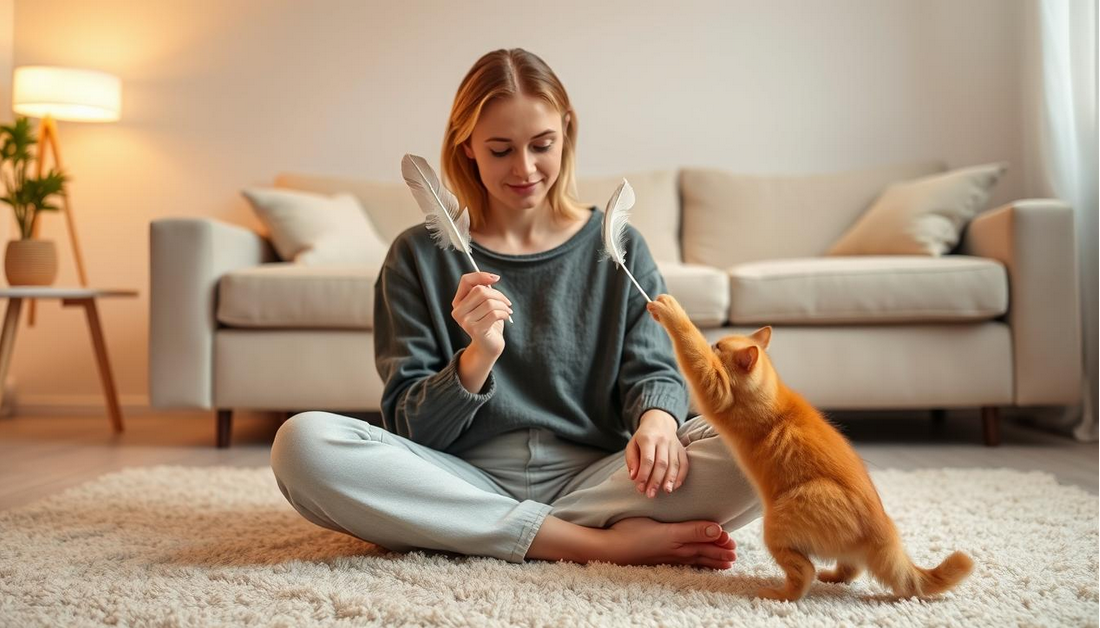
Feeding and Water Station Setup
A well-designed feeding and water station setup is vital for your cat’s health and hygiene. Consider using elevated feeding stations to reduce strain on your cat’s neck and joints.
Food Puzzle Options for Mental Stimulation
Food puzzle toys provide mental stimulation and challenge your cat to work for their food. This can help reduce boredom and stress.
| Feature | Traditional Feeders | Food Puzzle Toys |
|---|---|---|
| Mental Stimulation | Low | High |
| Eating Speed | Fast | Slower |
| Boredom Reduction | No | Yes |
Litter Box Placement and Privacy
Litter box placement is critical for your cat’s privacy and comfort. Place litter boxes in quiet, low-traffic areas to reduce stress.
Multi-Cat Litter Box Solutions
For multi-cat households, provide one litter box per cat, plus one extra. This can help reduce competition and stress among cats.
Temperature and Lighting Considerations
Maintaining a comfortable temperature and lighting environment is essential for your cat’s well-being. Cats prefer temperatures between 65-75°F (18-24°C).
By carefully designing these essential elements, you can create a harmonious and comfortable indoor space that enhances your cat’s quality of life.
Vertical Space: Why Height Matters to Cats
Creating vertical space for cats is not just about aesthetics; it’s about fulfilling their instinctual needs. Cats are natural climbers, and providing them with vertical spaces can significantly enhance their indoor environment.
Cat Trees and Climbing Structures
Cat trees and climbing structures are essential for cats as they allow them to exercise, observe their surroundings, and claim territory. When selecting a cat tree, consider the size and stability to ensure it meets your cat’s needs.
Choosing the Right Size and Stability
A sturdy cat tree that is tall enough for your cat to climb and perch is ideal. Look for structures with wide bases to prevent tipping and ensure the material is durable.
Wall-Mounted Shelves and Perches
Wall-mounted shelves and perches offer cats additional vantage points and resting areas. They are particularly useful in smaller spaces where floor-based cat trees might not be feasible.
DIY Installation Tips
To install wall-mounted shelves, choose sturdy brackets that can support your cat’s weight. Ensure the shelves are level and securely fastened to the wall studs for maximum stability.
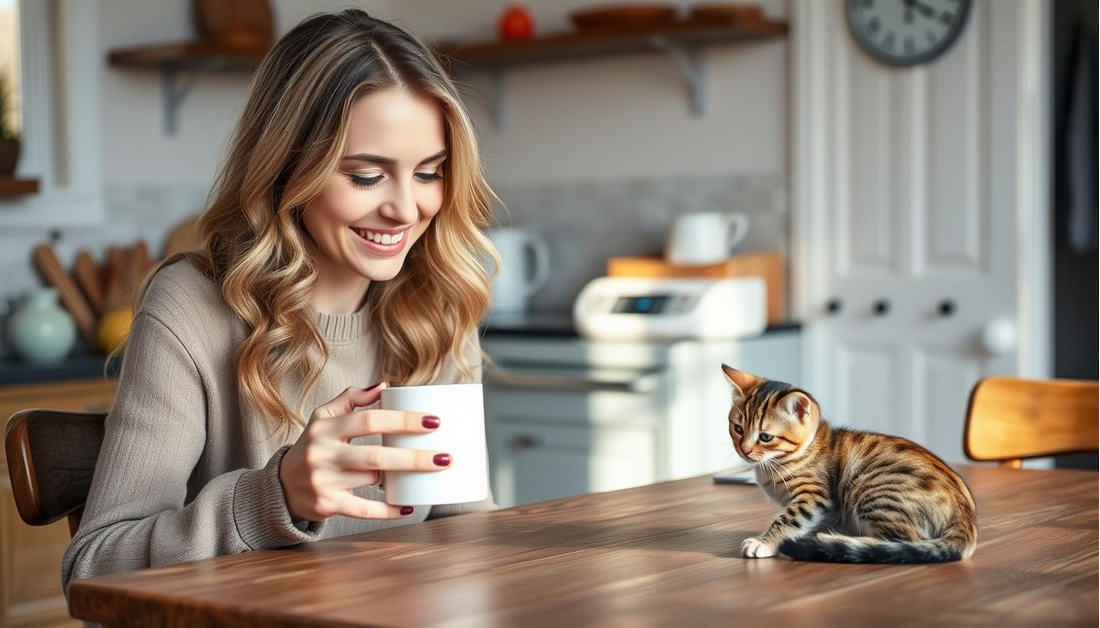
Window Access Points
Providing cats with access to windows allows them to observe the outdoors, which is a great source of entertainment and stimulation.
Window Perches and Catios
Window perches can be installed directly onto the windowsill, providing a comfortable spot for cats to lounge and watch the outside world. Catios, or enclosed outdoor spaces attached to windows, offer a safe way for cats to experience the outdoors.
DIY Vertical Space Solutions
For those on a budget, DIY vertical space solutions can be a fun and cost-effective way to enhance your cat’s environment.
Budget-Friendly Climbing Options
Consider repurposing household items, such as cardboard boxes or wooden crates, to create climbing structures. You can also build your own cat shelves using reclaimed wood and simple brackets.
| Solution | Cost | DIY Involvement |
|---|---|---|
| Cat Trees | $50-$200 | Low |
| Wall-Mounted Shelves | $20-$100 | Medium |
| Window Perches | $15-$50 | Low |
| DIY Climbing Structures | $0-$50 | High |
Play and Exercise Areas for Indoor Cats
Play areas for indoor cats are not just a luxury, but a necessity for their health and happiness. Indoor cats need regular play and exercise to stay healthy and active. A well-designed play area can stimulate their natural hunting behavior and provide the necessary physical activity.
Interactive Toy Selection
Choosing the right toys for your indoor cat is crucial. Interactive toys that encourage natural hunting behavior are particularly effective. These toys not only provide entertainment but also help in maintaining your cat’s physical and mental health.
Wand Toys and Laser Pointers
Wand toys with feathers or other attachments and laser pointers provide excellent exercise and stimulation. They encourage your cat to run, jump, and pounce, mimicking their natural hunting instincts.
Automated Play Options
Automated toys can keep your cat engaged even when you’re not around. These toys can be programmed to move or dispense treats, providing your cat with a fun and challenging way to spend their time.
Creating Engaging Play Zones
Designating specific areas for play can help keep your home organized and your cat entertained. These areas can be tailored to your cat’s preferences and needs.
Tunnels and Exploration Areas
Tunnels and enclosed spaces allow cats to hide, seek, and explore. These areas can be created using cardboard boxes or purchased tunnel systems, providing your cat with a sense of security and adventure.
Exercise Wheels and Activity Centers
Exercise wheels and activity centers provide cats with a way to get cardiovascular exercise indoors. These are especially useful for cats that are prone to obesity or need to burn off excess energy.
Rotating Toys to Maintain Interest
Rotating toys regularly can keep your cat interested and prevent boredom. By introducing new toys or reintroducing old ones, you can keep playtime fresh and exciting.
Toy Storage and Rotation Schedule
Storing toys and creating a rotation schedule can help keep playtime fresh. This can be as simple as storing toys in a closet and switching them out every few days.

| Toy/Activity | Frequency of Use | Benefits |
|---|---|---|
| Wand Toys | Daily | Encourages exercise and hunting behavior |
| Tunnels | Several times a week | Provides hiding spots and exploration areas |
| Exercise Wheels | Daily | Promotes cardiovascular health |
Scratching Solutions: Protecting Your Furniture
Scratching is an innate behavior for cats, serving multiple purposes, from nail care to territorial marking. This natural behavior can often lead to damage to household furniture, making it essential for cat owners to understand why cats scratch and how to redirect this behavior to appropriate scratching posts.
Understanding Scratching Behavior
Cats scratch for various reasons, including marking their territory with scent glands in their paws and maintaining their nail health by shedding old nail cells. Understanding these motivations is key to addressing the behavior.
Why Cats Need to Scratch
Scratching is not just a physical need but also an emotional and psychological one. It allows cats to stretch, exercise, and relieve stress. Providing adequate scratching solutions can significantly reduce damage to furniture.
Types of Scratching Posts and Surfaces
There are various types of scratching posts and surfaces available, catering to different preferences. The main types include:
- Vertical scratchers
- Horizontal scratchers
- Cardboard scratchers
- Sisal rope scratchers
- Carpeted scratchers
Horizontal vs. Vertical Scratchers
The orientation of the scratcher can significantly impact its appeal to cats. Some cats prefer scratching vertically, while others prefer horizontal surfaces.
Material Preferences: Cardboard, Sisal, Carpet
Cats have different material preferences when it comes to scratching. A comparative analysis of popular materials is presented below:
| Material | Durability | Cat Preference |
|---|---|---|
| Cardboard | Low | Moderate |
| Sisal | High | High |
| Carpet | Moderate | High |
Strategic Placement of Scratching Areas
Placing scratching posts near areas where cats tend to scratch can help redirect their behavior. It’s also beneficial to place them in high-traffic areas or near sleeping spots.

Training Cats to Use Designated Scratching Areas
Training your cat to use designated scratching areas involves patience and positive reinforcement. Encouraging cats to scratch appropriate surfaces can be achieved through:
Positive Reinforcement Techniques
Rewarding your cat with treats or praise when they use the scratching post can reinforce the desired behavior. Consistency is key to successful training.
Creating Comfort: Cozy Retreats and Hiding Spots
Cats need hiding spots to reduce stress and feel safe. Providing such spaces is crucial for their well-being and can significantly impact their behavior and overall happiness.
The Importance of Safe Havens
Safe havens or hiding spots are essential for cats as they provide a sense of security and comfort. These areas allow cats to retreat from the stresses of their environment and relax.
Stress Reduction Through Private Spaces
Private spaces help in reducing stress by giving cats a quiet, undisturbed area where they can rest. This is particularly important in busy households where noise levels can be high.
Enclosed Beds and Cat Caves
Enclosed beds and cat caves are excellent options for creating cozy retreats. These structures provide cats with a sense of enclosure and protection, making them feel safe and secure.
DIY Hiding Spots Using Household Items
You can create hiding spots using household items like cardboard boxes or blankets. Simply drape a blanket over a box or a small table to create a cozy cave. Cats often find these makeshift hiding spots very appealing.
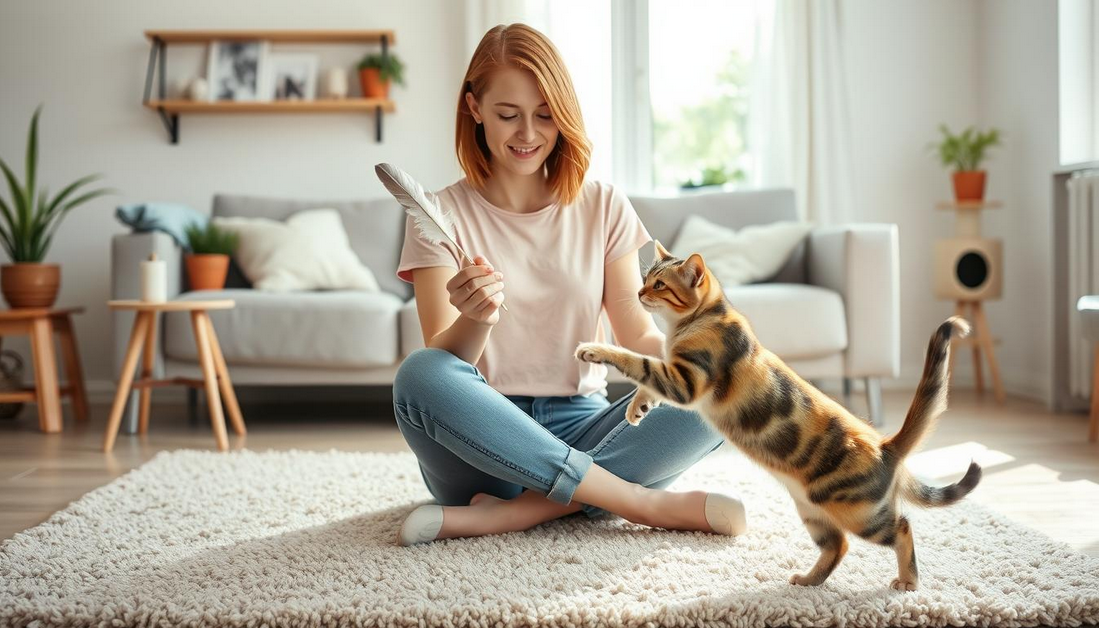
Multi-Cat Households: Ensuring Each Cat Has Space
In multi-cat households, it’s crucial to ensure that each cat has its own space. Providing multiple hiding spots and retreats can help prevent conflict among cats.
Resource Distribution to Prevent Conflict
Distributing resources such as food, water, and litter boxes across different areas can help reduce competition and stress among cats. Ensuring that each cat has access to these resources without feeling threatened is key.
Calming Products for Anxious Cats
For anxious cats, calming products such as pheromone diffusers can be very effective. These products mimic the natural pheromones that mother cats produce to calm their kittens, helping to reduce anxiety in cats.
Pheromone Diffusers and Calming Aids
Pheromone diffusers are a popular choice for calming anxious cats. They work by releasing synthetic pheromones into the air, creating a calming environment. Other calming aids include calming treats and collars.
Sensory Enrichment for Indoor Cats
Sensory enrichment is a vital aspect of caring for indoor cats, providing them with the stimulation they need. Indoor cats often lack the variety of stimuli that outdoor cats take for granted, making it essential for cat owners to create an enriching environment.
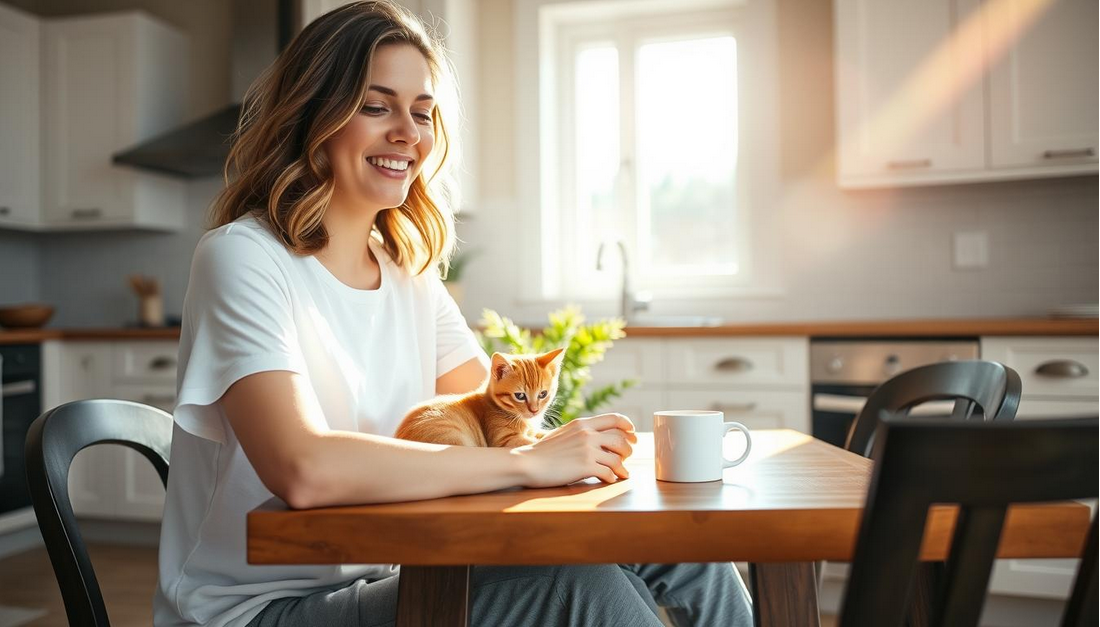
Visual Stimulation: Bird Feeders and Digital Entertainment
Visual stimulation is a critical component of sensory enrichment. One effective way to provide visual stimulation is by placing bird feeders near windows, allowing your cat to observe wildlife. As “Cats are natural predators, and watching birds can be a great source of entertainment for them.”
Cat TV and Window Entertainment
In addition to bird feeders, “Cat TV” or digital entertainment can be a valuable resource. Many cats are fascinated by screens displaying nature documentaries or cat-specific content. “According to a study, cats can be entertained by watching fish on a screen, which can be a calming and stimulating experience.”
“The simple act of watching birds outside a window can be a significant source of entertainment and stimulation for indoor cats.”
International Cat Care
Olfactory Enrichment: Cat-Safe Plants and Herbs
Olfactory enrichment is another crucial aspect. Cats have a highly developed sense of smell, and certain plants and herbs can be very appealing to them. Cat-safe plants like catnip, silver vine, and cat grass are excellent choices.
Catnip, Silver Vine, and Cat Grass
Catnip and silver vine are known for their ability to stimulate cats’ senses. Cat grass, on the other hand, provides a safe alternative for cats to graze on. Incorporating these into your cat’s environment can significantly enhance their sensory experience.
Auditory Considerations: Managing Noise Levels
Auditory considerations are also important. Cats can be sensitive to noise, so managing the auditory environment is crucial. Providing a quiet space or using white noise machines can help create a more comfortable environment for your cat.
Tactile Variety: Different Textures and Surfaces
Tactile variety is essential for cats, who enjoy exploring different textures and surfaces. Incorporating various materials into their environment, such as scratching posts, carpeted cat trees, and soft bedding, can provide the necessary tactile stimulation.
Incorporating Various Materials in Cat Spaces
When designing your cat’s spaces, consider incorporating a range of materials. For example, sisal rope for scratching posts, plush fabrics for beds, and cardboard boxes for hiding spots. This variety will keep your cat engaged and interested in their surroundings.
Conclusion: Creating a Harmonious Space for You and Your Cat
Designing a cat-friendly home is all about balance. By understanding your cat’s natural behaviors and incorporating elements of safety, enrichment, and comfort, you can create a harmonious space that promotes happiness and well-being for both you and your feline companion.
A cat-friendly home design should include essential elements such as designated resting areas, feeding and water stations, litter box placement, and temperature and lighting considerations. Providing vertical space through cat trees, wall-mounted shelves, and window access points can also enhance your cat’s environment.
To ensure indoor cat happiness, it’s crucial to incorporate play and exercise areas, scratching solutions, and cozy retreats. Sensory enrichment through visual stimulation, olfactory enrichment, and tactile variety can also contribute to a comfortable indoor space for cats.
By implementing these eco-friendly indoor cat solutions, you can create a space that is enjoyable for everyone. A well-designed cat-friendly home not only improves your cat’s quality of life but also strengthens the bond between you and your pet.

